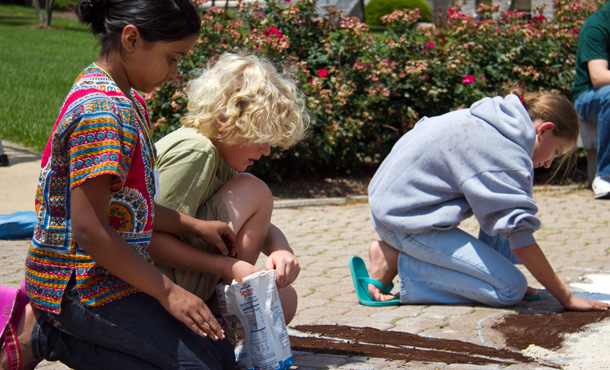What does a bike-powered ice-cream maker have to do with peace and justice?
A lot, for the 47 children from grades 1-6 attending June’s Interfaith Peace Camp — a collaboration by Eastern Mennonite University’s Center for Interfaith Engagement with local faith communities. “At the heart of peacebuilding is relationship building,” notes a statement of the camp’s purpose.
Following its 2011 theme, “Earth Care-People Care,” campers learned about sustainable living on visits to Jewish, Christian and Muslim places of worship, as well as the New Community Project (NCP) mini-farm in north Harrisonburg.
The morning at NCP – where attractions include the abovementioned dessert-producing workout device – immersed kids in aspects of sustainability that, incidentally, proved fun:
Painting the recycling shed (and each others’ faces). Shaking sand and clay on a tarp to prepare for making a cob oven. Setting out cucumber plants. Staining hands picking mulberries for ice-cream topping.
As the mulberry mix boiled over a small cylindrical stove, children took turns working the churn from the stationary tandem bike – a local invention.
When NCP director Tom Benevento dumped a compost bucket of aging kitchen refuse, he heard shouts of “Eeeew!” After covering it with weeds, he pointed to an older batch. “It’s starting to turn,” he indicated. “It also used to look grody.” The children – some experienced gardeners, others not – observed nature’s work on compost’s scent and appearance.
They hoped to make brownies. A volunteer led a discussion exploring, “How are brownies like fossil fuels?” NCP’s homemade sun oven – a glass-covered box employing tin panels – read 225 degrees. Brownies required about 350.
This summer’s peace camp – in its fourth year – had 40 slots, but demand entailed adding a few while turning some away. It’s all volunteer-run, with expenses supported by fees and donations.
“Every year it’s gotten better,” said camp administrator Gretchen Maust. She and co-director Lynette Mast noted diversity has increased as relationships have grown. This year, five children from Harrisonburg’s relatively small Beth El Congregation attended the weeklong day camp, with remaining attendance coming about equally from Christian denominations and the Islamic Association of the Shenandoah Valley.
One afternoon, campers Matthew Bacheller, Lauren Gumm and Abbie Menard gathered beside EMU’s fountain to remove and sort petals from cut flowers. They’d just visited and had lunch at the Harrisonburg mosque. “They have really soft carpet,” Lauren recalled, adding, “It’s always fascinating to learn about other religions.” She also liked the lentil soup.
Abbie had asked why Muslim women wear head coverings. “It’s because women are like jewels,” explained Matthew – whose sister, junior counselor Adara Bacheller, wore a bright purple hijab.
Earlier, the group had visited Beth El, where member and camper Hannah David reported they lunched on gefilte fish, latkes and “a noodle food.” She appreciated visiting the mosque and churches.
Beth El member and local educator Ron Ornstein, on guitar, led campers in garden-song sessions.
“We’re hosting, but in a way, each group is hosting,” said EMU art professor Cyndi Gusler, who facilitated construction of a rangoli around the fountain.
A rangoli, camper Fiza Afridi explained, is a creation originating in India that “welcomes people. It makes them feel happy.”
After children created rangolis on paper, Gusler incorporated their design elements – a splash; lotus; flower petals; spiral; nautilus – into a master drawing for chalking on the sidewalk.
Next came colors, textures and aromas.
Children encircled the fountain with a green ring made from plantain and seedpods. Chrysanthemums, blue coneflowers and red and yellow roses came from a florist’s still-colorful discards. In addition to those petals, children – mostly using only hands – neatly filled the chalked outlines for blossoms and leaves with flour, rice, ground coffee and curry.
While the peace camp focuses on Abrahamic faiths, this year, Gusler used art representing other traditions. Hence the rangoli, often used in Hindu celebrations, which also embodies the earth-care theme.
“Rangoli is a festival art,” she explained. “People walk through it and carry the spices on their feet. It’s meant to be very transient, to blow away and just go back to the earth.”
That mostly happened within a few days, but friendships – seeds of peace – would endure.
———–
Chris Edwards is a free-lance writer from Harrisonburg.
